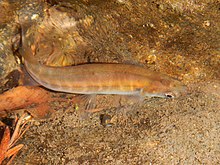Banded kōkopu
| Banded kōkopu | |
|---|---|

| |
| Banded kōkopu | |
| Scientific classification | |
| Domain: | Eukaryota |
| Kingdom: | Animalia |
| Phylum: | Chordata |
| Class: | Actinopterygii |
| Order: | Galaxiiformes |
| Family: | Galaxiidae |
| Genus: | Galaxias |
| Species: | G. fasciatus
|
| Binomial name | |
| Galaxias fasciatus J. E. Gray, 1842
| |

| |
The banded kōkopu (Galaxias fasciatus) is a
Description

Banded kōkopu are a stout-bodied fish, with a large head and mouth. The fish are strong, rounded and fleshy. Like other galaxiids, the dorsal and anal fins are positioned close to the tail fin, which is short and square. The caudal peduncle is short and deep, with thick fleshy flanges which join the tail fin.[3]
Adults are usually a dark, earthy brown or olive brown, with pale yellow vertical bands along the body. The belly is light coloured and unpatterned.[3] Behind the operculum and above the pectoral fin is a silver or white mark, and sometimes a darker mark behind this. The bands either fade out top and bottom, or fork and crisscross the back of the fish. In small fish the bands are usually numerous and along the whole body, but in adults the bands become narrower and are often restricted to the rear third of the body.[4] Although the bands change as the fish ages, the placement and shape of the bands are consistent enough to be used for individual identification over several years.[5]
Medium and juvenile
Distribution
Banded kōkopu are found only in New Zealand and just a handful of spawning sites are known. In 2018 a new spawning site was discovered in a tributary of York Stream, Nelson, where fish habitat and passage restoration has been carried out as part of Project Maitai.
In Nelson banded kōkopu occupy creeks and tributaries in lowland coastal flats and can penetrate inland to take refuge in pools/undercut banks in tributaries with over hanging vegetation.
Life cycle
Banded kōkopu are diadromous, spending the first 3–4 months of life at sea, before migrating back to freshwater as whitebait of 40–45 mm (1.6–1.8 in) in length.
Banded kōkopu become sexually mature at two or three years old.[3] They spawn in adult habitats during flood events in autumn and early winter, laying the 2 mm (0.079 in) diameter eggs amongst flooded vegetation and leaf litter on the edge of the stream.[7][8] As the flood recedes the eggs are left to develop out of the water; the high humidity provided by the vegetation keeps them moist.[7] After three to four weeks the embryos are fully developed and require a second flood to stimulate them to hatch, and the larvae are carried to sea on the floodwaters.[7] They live amongst and on the plankton for 3–4 months before returning to freshwater.
Juvenile banded kōkopu can detect and are attracted to odours produced by adults. This suggests they have the ability to discriminate species-specific pheromones during their migratory phase, which alerts juveniles to suitable habitat based on the presence of adults.[9]
Banded kōkopu can live for at least nine years,[10] possibly longer, and spawn multiple times over their lifetime.
Behaviour
Banded kōkopu are largely nocturnal, and may be easily and unobtrusively observed night, ideally using red light.[11] Banded kōkopu may also be observed during the day if undisturbed.[4]
Juvenile banded kōkopu are one of five species of
References
- . Retrieved 12 November 2021.
- ^ "Banded kōkopu". NIWA. 2009-06-04. Retrieved 2021-07-15.
- ^ ISBN 0-7900-0725-8.
- ^ ISBN 0-7900-0022-9.
- ^ S2CID 84892795.
- ^ ISBN 978-1-86966-386-5.
- ^ S2CID 129117686.
- .
- ISSN 1095-8649.
- .
- ^ McCullough, C. D. & Hicks, B. J. (2002). Estimating the abundance of banded kokopu (Galaxias fasciatus Gray) in small streams by nocturnal counts under spotlight illumination. New Zealand Natural Sciences 27: 1-14p.
- Martinez-Capel, F.; McCullough, C. & Hicks, B. J. (2004). On a regional model for nocturnal habitat requirements of banded kokopu (Galaxias fasciatus) in the North Island, New Zealand. Fifth International Symposium on ISBN 90-805649-7-4.
- "Galaxias fasciatus". Integrated Taxonomic Information System. Retrieved 6 June 2006.
- Froese, Rainer; Pauly, Daniel (eds.) (2006). "Galaxias fasciatus" in FishBase. March 2006 version.
External links
- New Zealand native freshwater galaxiid fish, Banded kokopu TerraNature, Auckland 2010

